A name like rainbow eucalyptus promises to be a colourful and beautiful tree – luckily, this tree really does live up to its name. Nature collaborated to make an amazing natural beauty with this one.
In our how to grow and care guide, we’ll have a look at an introduction to the rainbow eucalyptus, how to propagate the tree, how to care for it, pests and diseases, and some frequently asked questions about this colourful tree.
More...
Family: | Myrtaceae |
|---|---|
Genus: | Eucalyptus |
Species: | E. deglupta |
Common Names: | Rainbow eucalyptus, rainbow gum, Mindanao gum |
Location: | Outdoor |
Type: | Tree |
Growth: | Up to 30 metres tall, between 18 and 30 metres wide |
Sun requirements: | Full sun |
Foliage Colour: | Green |
Flower Colour: | White |
Flowering: | Varies |
Fruit: | None |
Maintenance level: | Low |
Poisonous for pets: | Yes |
Introducing the Rainbow Eucalyptus
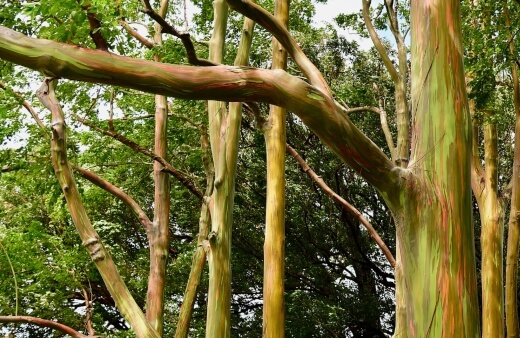
The Eucalyptus deglupta or the rainbow eucalyptus as it is better known, is a very tall type of tree native to the Philippines, Indonesia, and Papua New Guinea. It is also sometimes known as Mindanao gum.
This tree is unique as it’s the only type of eucalyptus which grows and lives in a rainforest and the only type of eucalyptus indigenous to the northern hemisphere.
The height of the rainbow eucalyptus is impressive, and it can reach up to 30 meters high. They grow incredibly fast and handle pests and diseases well.
Eucalyptus deglupta Plant Features
What makes the rainbow eucalyptus truly stunning is that it has colourful bark. The colours are created when the tree sheds its bark, and you first see a bright green layer.
When this bark layer makes contact with the air and as it ages over time, the colours then change into red, orange, blue, pink and purple, making it a truly beautiful sight.
The layers are never the same colour as they fall off and age in different stages. In terms of commercial value, you would think the colourful bark could be used creatively but it’s actually used as pulpwood which makes white paper.
The rainbow eucalyptus has wide white flowers with big evergreen leaves that produce a good smelling oil, although it doesn’t produce very much of it. If you’re thinking of growing this tree, you’ll need to make sure you can provide full sun and a moist soil.
How to Grow Rainbow Eucalyptus
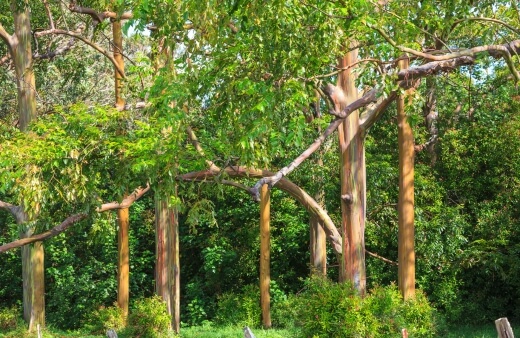
Since it originates from the rainforest and clearly enjoys the rain, you’ll need to top up on watering if there isn’t much rain. The rainbow eucalyptus doesn’t tolerate frost so keep your climate in mind.
Of course, another important consideration is the size of the tree which might not be ideal for most home gardens. This tree has raised roots that are incredibly strong. That means they could damage parts of your home and surroundings if planted too close.
The rainbow eucalyptus can live a long life if the conditions are right, and the range is between 50 and 150 years. If you were thinking of an indoor tree, you’ll need to do some more research as the rainbow eucalyptus is just too big for inside the home.
Bear in mind that the tree is poisonous to animals, so you’ll need to watch pets carefully. The actual eucalyptus oil is toxic if you swallow it.
Propagating Rainbow Eucalyptus
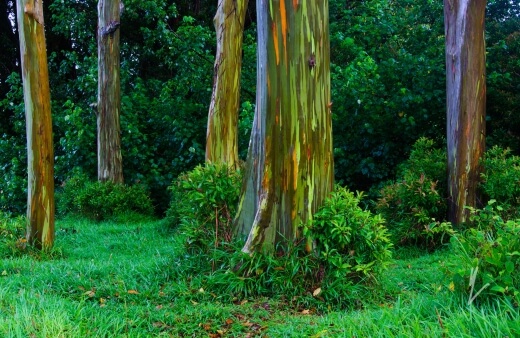
Rainbow Gum Propagation from Cuttings
If you are going to grow a rainbow eucalyptus from a cutting, be sure to take it from a tree not older than 5 years for best chances of success.


Get Your Free Guide:
Master Growing Australian Natives eBook
A Must Have Complete Guide for Every Australian Garden
Get Your Free Guide:
Master Growing Australian Natives eBook
A Must Have Complete Guide for Every Australian Garden
Choose a stem or cutting that has a leaf segment on it and dip in rooting hormone before planting it. Place the cutting somewhere warm and humid to help the germination process.
Growing Mindanao Gum from Seeds
If you can aim for a temperature around 32°C, it will help the germination process along. You want to sow the seeds just on the surface of moist soil and then place it somewhere sunny.
The soil should stay moist so don’t let it dry out. Germination can take between 1 and 3 weeks. When the seedlings are at least a year old you can then plant them outside.
We’ve got honest, in-depth reviews and information on all kinds of gardening tools and equipment. Whether you are looking for everyday gardening equipment, or tools for specific jobs around the garden, you can find everything you need to know about gardening tools and products here.
Rainbow Eucalyptus Care Guide
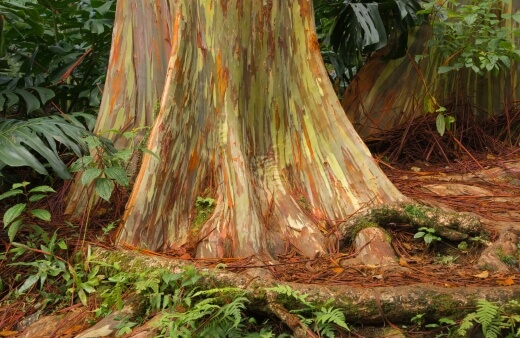
Sunlight Preference
The rainbow eucalyptus tree likes the sun and plenty of it. That means it will need to be planted in a position with uninterrupted light. Imagine someone who likes to sun tan all day every day the minute the sun comes out.
What Soil to Use
Your soil choice for the rainbow eucalyptus should be sandy, loam, moist, and well-draining. It also likes a neutral or slightly acidic pH. The well-draining aspect is key here otherwise you could end up with disease like root rot.
Watering Schedule
Once your rainbow eucalyptus tree has established itself, it will be able to handle drought quite well. During their first year of life though, you’ll need to water your tree often.
The balance here is to keep the tree moist but be careful not to let the soil become waterlogged. Using mulch also helps to lock in moisture, it just mustn’t touch the tree trunk.
See our guide on different types of mulches and when to use them here.
Temperature and Humidity
21 to 29°C is the ideal temperature for your rainbow eucalyptus tree. It also likes humidity. The colouring of the tree bark is very closely linked to the temperature the tree is growing in, how much humidity there is and also if it gets good airflow.
If you feel that your tree is not looking all that vibrant, perhaps you can review if these conditions are right.
Fertilising Rainbow Gum
If you choose the right soil for your rainbow eucalyptus to start off with, you probably won’t need to use fertiliser. You might want to offer some extra nutrients and that is absolutely fine.
If you are going to use some fertiliser, just remember this tree doesn’t like phosphorus.
Pruning Rainbow Eucalyptus
The rainbow eucalyptus doesn’t really need pruning – you can of course opt to prune if you’re aiming for a specific shape or size. A good idea is to get rid of any damaged branches at the end of winter or the start of spring.
Think of it as a spa treatment for your tree – out with the old and in with the new.
Whether you’re a beginner to gardening or a gardening expert, we’ve got gardening tips and tricks specific to Australian gardens, to help you bring your garden to its full potential. Browse our articles on everything from composting to lawn care.
Common Rainbow Eucalyptus Pests and Diseases
The rainbow eucalyptus tree is quite a toughie – it handles disease well. The peeling off of its bark means it gets rid of quite a few pests so this tree is not just a pretty face.
Unfortunately root rot is something you might have to deal with so let’s look at two different types below and what you can do about it.
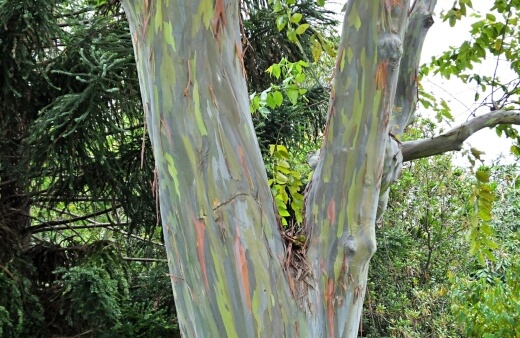
Root rot
If you want to know if you’re dealing with root rot, make sure the roots of your plant are not soft and brown. The sign of a healthy root system is white and solid.
This is where soil care is extremely important. If the soil is soggy or waterlogged and doesn’t drain properly, it’s the perfect place for fungal spores to spread.
The roots actually start to die as the fungus spreads and then the tree won’t be able to absorb any nutrients. If you notice yellow or wilting leaves, it’s possible that you’re dealing with root rot. The overall plant growth will slow down and you might not see any flowers.
If you’re sure you’re dealing with root rot, you’ll need to make a call if the tree can actually be saved. When checking the roots, if you see that the entire root system is mushy, you probably can’t do anything.
If you still see some white roots, you can provide fresh soil and make sure the drainage is good. You’ll need to get rid of brown and mushy roots and can use sharp scissors to do this pruning process. Once you’ve pruned off the dead roots, be sure to sterilise your tools.
Armillaria root rot
Another type of root rot, called Armillaria root rot, could take a liking to your rainbow eucalyptus. In Australia, this is caused by a fungus called Armillaria luteobubalina, and in other parts of the world it might be known as the honey toadstool or the bootlace fungus.
Symptoms that you are looking out for are yellow leaves, stunted growth and dying back of the branches. If you strip a piece of bark, you might see areas of the white fungus in the infected wood.
Sometimes there are also dark strands of fungus which actually grow in the soil and attach themselves to the roots. You’ll need to prune out the tree bark and roots that have been affected.
See our review for the best garden loppers to help you in your bigger pruning tasks.
You can actually paint the parts of the tree where you have made cuts for pruning, with a paint that’s made for plastic. It’s best to uncover the crown and roots of the tree and leave them exposed to the air.
The air exposure actually helps to kill off the Armillaria fungus. It’s best to burn any parts of the tree that you have pruned off to get rid of them safely and to make sure that no other plants and trees are affected or infected.
Rainbow Eucalyptus Frequently Asked Questions

Is it true that the rainbow eucalyptus helps with carbon reduction?
Yes, this is one of the great qualities about this tree. In fact, trees like the rainbow eucalyptus that shed their bark are popular to line streets in places that have a lot of pollution.
The bark absorbs the air pollution so when it gets rid of it, it’s getting rid of some of the pollution too that has built up in the tree. Like we said, this tree is not just a pretty face.
What are some of the benefits of the rainbow eucalyptus tree?
The wood of the tree actually keeps its colour, even once cut and used. This means that furniture made from the rainbow eucalyptus will have some gorgeous shades of green and brown to add character.
What’s even more amazing, is that the rainbow eucalyptus can help to control and prevent malaria. How does it do this? Well, we know that it’s a thirsty tree.
This means that in areas that are swamp land and prone to mosquitoes which like these conditions, the tree actually helps to soak up the moisture.
Is the rainbow eucalyptus considered an invasive species?
You wouldn’t think that a tree so beautiful could be, but yes, it is considered an invasive species in many parts of the world. In the USA for example, it is considered invasive in almost every State.
Looking for more gardening help and inspiration? Subscribe to our newsletter here and enjoy top gardening tips for everyday people. We are dedicated to helping you grow a better garden.
Wrapping Up Our Rainbow Eucalyptus Growing and Care Guide
Investing in growing a rainbow eucalyptus is not for everyone, considering the magnificent size, but if you’ve got the space, you’ll be greatly rewarded.
The tree is low maintenance, can be propagated from cuttings or seed quite easily, and if you manage its growing conditions well, you shouldn’t really have much to deal with in terms of pests or diseases. We’re giving the amazing rainbow eucalyptus our green thumbs up!
Published on September 27, 2022 by Nathan Schwartz
Last Updated on March 5, 2025





Hello Nathan,
I am looking to grow from seed some rainbow gum trees in Darwin
Both locations will have good sun.
Darwin has a Wet/Dry climate (Not wet tropics), The trees will have good watering. Will they be colourful in our climate?
One location for planting is an inner suburb of Darwin that has plenty of sandy loamy black soil on top of bedrock ranging 1.5 to 5 metres underground so that should be OK
The other location has lots of clay below ground and don’t know to what depth. Do these trees do well in Clay soils?
Do you see a problem with these sites? Do they prefer accompanying rainbow gums planted alongside?
Finally what is the typical diameter of the tree?
It is interesting that your comment states that these trees are regarded as invasive in many parts of the world.
The Island of New Guinea is part of Sahul (Sahul is the name given to the land mass comprising Tasmania, Mainland Australia, New Guinea and Acu Islands that separated into separate land masses with the end of the last ice age 10,000 to 15,000 years ago).
The Rainbow gum is therefore a pseudo Australian native.
In my various travels and trecks in PNG, I have to say I did not see such a tree there.
Cheers
William Proft.
Hi William,
Thanks for getting in touch, and thanks for such a specific question too. For most of the questions above, I’d say yes to all, but with a but for all:
1. They’ll grow in clay soils (but can struggle to establish – once established, they’re fine in all conditions. So just add a load of grit, gravel, or anything to help drain the base of the planting hole while roots settle in.
2. They’ll grow with any other trees alongside. No need to stick to just rainbow gums, but you’ll get a better overall effect by planting a swathe of the single species.
3. They grow to nearly 80m tall, so their trunks easily reach 2m in diameter. I think there are reports of some with 3m diameter trunks.
But, as for the most important part of that question… will they have good colour? Almost definitely. Rainbow gums have their best colour in bright, hot conditions, and nearly always develop that characteristic colour.
Best regards,
Nathan Schwartz